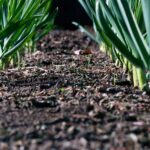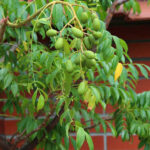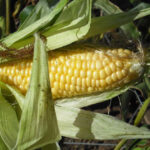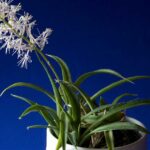Gardeners today are increasingly concerned with ecologically sound practices. Many have focused on building healthy soil, or sourcing materials from companies that provide environmentally conscious products. One topic is very important in this vein: collecting rainwater for irrigation.
Rainwater collection has several benefits, and finding the right collection system for your needs is important. So today, we’ll talk about the ways you can begin catching rainwater. Harvesting rainwater will not only give you nutrient-rich irrigations to feed your plants, but it will also help you minimize your water bill.
Whether you live in a state like Washington, where rainfall is plentiful, or Texas, where some places have scarce precipitation, collecting and harvesting water will benefit your household. Create the right system for your situation, and we’re talking free irrigation.
Why Is Collecting Rainwater Important?
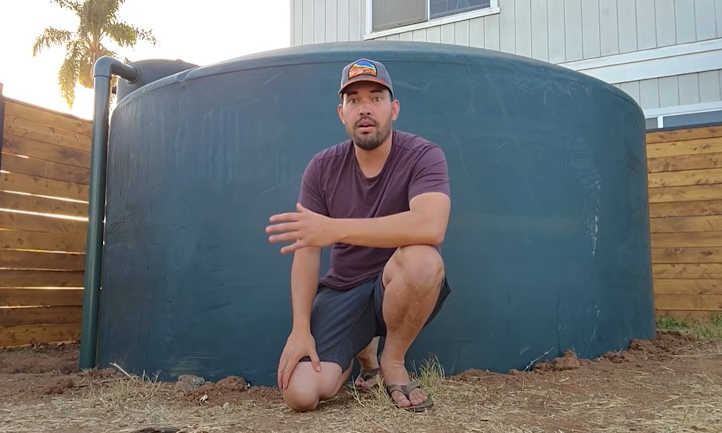
Water conservation is important today to a greater extent than it has been in the past. Topsoil loss has made natural waterways less useful due to a buildup of toxins. In municipalities, the major source of water may be running out. This makes the ecological urgency of rainwater harvesting greater.
Collecting rain is an important part of ecologically sound gardening practices, especially in the western parts of the United States where 72% of the region is in “severe drought”. Turning on an irrigation system for an hour a day might be a thing of the past in just a few years. So why not take up the helpful practice of water catchment now to prepare for what seems like an inevitability? Unless you are going for a full 5000-gallon cistern system, setting up your own rainwater collection system can be very inexpensive and easy with the right amount of planning.
Rain water is great for plants because it contains more oxygen. This helps soil release the micronutrients that plants need. Collect water in rain barrels and you’ll find your plants burst with color and vitality. You also don’t risk pumping chemicals into the soil that might be present in tap water due to water treatment practices.
As rainwater flows off the surface of your household and into a cistern or rain barrel, it’s collected instead of moving onto the ground where flooding can occur. If you notice flood problem areas around your home a rain barrel might be a good idea. Barrels also don’t take up as much room as a swale or irrigation ditch does.
Overall, a free source of water that will truly feed your plants on site is an excellent way to ensure success in food production. Catch it, store it, and use it as needed.
Is Harvesting Rainwater Legal?
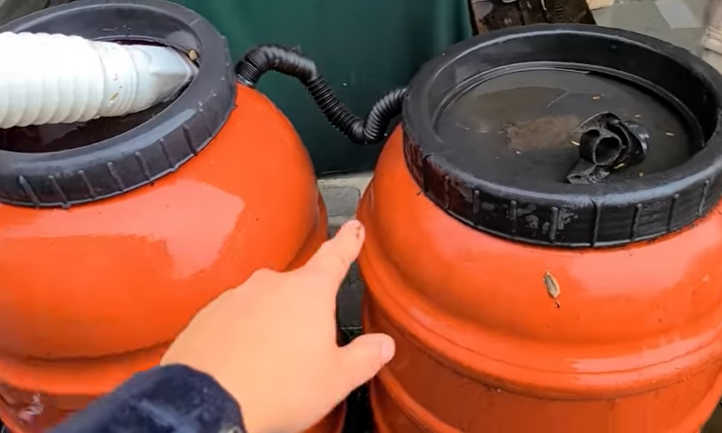
Although it seems counterproductive, some states restrict rainwater harvesting. Texas, California, Colorado, and others have determined that rainwater collection is legal, but collectors must follow stipulations.
Texas
In Texas, different counties have different rules for rainwater collection systems. Some areas must have the catchment incorporated into the building design if it’s meant to catch potable water, and local municipalities need to be informed so water testing can be done.
Colorado
Rainwater collected by individual homeowners in Colorado is typically limited to two barrels at about 110 gallons total. The water supply from the rainwater harvesting system cannot be used outside of the property.
California
Before 2012, it was illegal to capture rainwater off rooftops without obtaining a permit. However, now water collection is permitted statewide. It is still illegal to collect water from storm drains or stream channels. Water collected must be used for non-potable uses.
Illinois
Rainwater collected can only be used for non-potable purposes. Systems built for rainwater must follow the appropriate Illinois state code. HOAs may have specific regulations for the style and design of the system if they approve of rainwater harvesting for their residents.
Washington
Rainwater collected from rooftops in Washington must be used on the property where it’s collected. However, there are in-depth rules that vary by region on potable water sources. Those who want to use the water for drinking will need to contact their county to determine whether or not that’s allowed.
And Beyond
Several other states have requirements and restrictions when it comes to rainwater harvesting. Although it’s not illegal in any state in the US, knowing your water rights is important before you begin planning harvesting for your water needs. You don’t want to get into a situation where you’re knee-deep in install and cost to find that the way you planned your system is illegal.
Check your county’s laws and regulations for rainwater harvesting online. Know your water rights and you’re good to go!
Pros and Cons
Let’s talk about the benefits and pitfalls of rainwater collection systems. This will vary depending on the rain barrel or system you choose, so we’ll break this down by type.
Rain Barrels
A smaller rain water catchment system can hold a water supply of about 50 to 100 gallons stored in rain barrels. For many people, this is all they’ll need. It’s easy to set one up to collect water from your roof as it flows off the house in a storm. It’s easy to find a small barrel at your nearby hardware store or online, and the barrels won’t take up a ton of space in your yard.
The downfalls of a small system are that this much rainwater (50 to 100 gallons) might be too little. This could mean that your barrel overflows in a torrential downpour, wasting the hard work and effort you’ve put into the install. Installing rain barrels can involve a lot of futzing with a pipeline that needs to be rigged up to the gutter of your roof. Adding a second or third barrel to store additional rainfall could remediate this issue but it will require a more complicated setup.
Dry Systems
If you’ve used a small rain barrel (or barrels) to collect water, and you’ve found this isn’t enough room for the amount of rainfall you experience at your house, you might benefit from what’s called a dry system with a larger tank. A dry system means that the barrel fills from the top like a rain barrel does, so water doesn’t remain in the pipes leading to the system. In a place where rainfall is infrequent, having a larger store of water is useful. These water tanks also are easier to set up due to their proximity to your roof.
However, larger tanks can take a lot of energy to install next to your house due to their size. Like a rain barrel, they have to be installed near your house to allow for filling, which means that they can block access to other areas of your yard. In locations where rainfall is rare, oxidation can occur in the tank providing ample room for green algal and bacterial growth. These can ruin a water supply.
Wet Systems
A wet system is another large-scale option for rainwater collection. In this design, you install a tank away from your home and use multiple downspouts attached to gutters. Each downspout runs underground on your property and connects to tanks there. You can collect runoff from the entire surface of your roof, just as you can with a dry system. As the pipes are hidden, the benefit to this can be not only more volume, but it looks cleaner. Tanks located away from your home are nice too.
However, wet systems are called wet because they often retain some water in the buried pipes, and stagnant water can run the risk of developing bacterial or green algal growth. A large tank may be hard to clean, and they’re more difficult to install. Setting up an in-ground system from multiple gutters makes DIY installation a lot harder. Finally, you should know that large wet systems are costly. The economic benefit of a wet system does not outweigh municipal water. It can, however, be an important skill to have if the municipal water system fails.
Of course, before considering whether to work with a dry, wet, or small structure get to know the flow of your home, assess the cost, and compare your situation with the legality of water conservation in your municipality. In some areas, large tanks are not allowed.
DIY Rain Harvesting Ideas
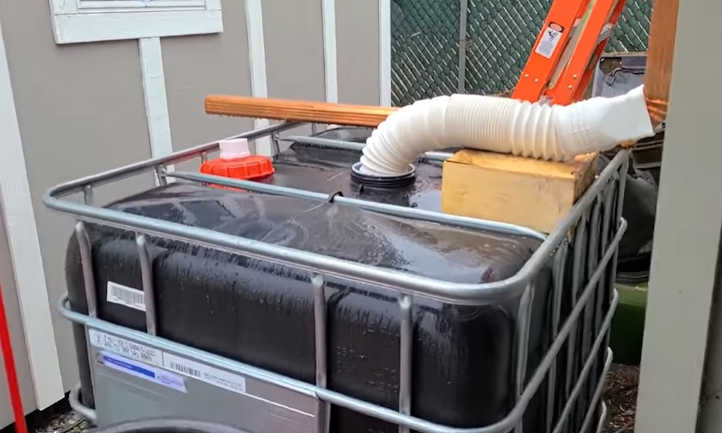
There are many different ways to harvest rainwater, and not all of them involve fancier systems. Here are some ideas for DIY rain harvesting that you can put to use.
Basic Rain Barrel
There are tons of rain barrel options for rainwater collection. There are collapsible barrels that can catch up to 50 gallons, and withstand harsh weather conditions. Alternately, there are sturdier, stylized options that are a little more costly but look good. You can even find DIY kits that provide all the tools you need to build your own.
Garbage Can Barrel
If any of the premade options are too expensive for you, no problem at all! Make your own with a garbage can and a sheet of fine netting affixed to the top underneath the lid. With a spigot connected to the bottom of the can, pump water through a hose and into your garden as soon as the water level is high enough. On average a garbage can holds about 32 gallons of water. This option is best for non-potable water.
Galvanized Stock Tank
Stock tanks are surprisingly effective as rainwater catchment systems. They’re sturdy and rust-resistant, and they’re stylish enough to sit just outside your house to harvest rainwater. Float mosquito dunks on the surface to prevent mosquito infestation, and they can work just as regular barrels do. Build a lid that keeps debris and light out of your stock tank for best use.
IBC Totes
These gigantic plastic totes are made for transporting large supplies of liquid, and they can be an effective rain storage method too! Opt for one that’s dark in color so it prevents light from penetrating the tank, as light can encourage algal growth. A caged IBC tote will be reinforced on its exterior with a metal cage, helping to support the weight of the liquid. These can be expensive, but they hold a serious amount of water and are great for DIYers.
DIY Rain Harvesting Tips
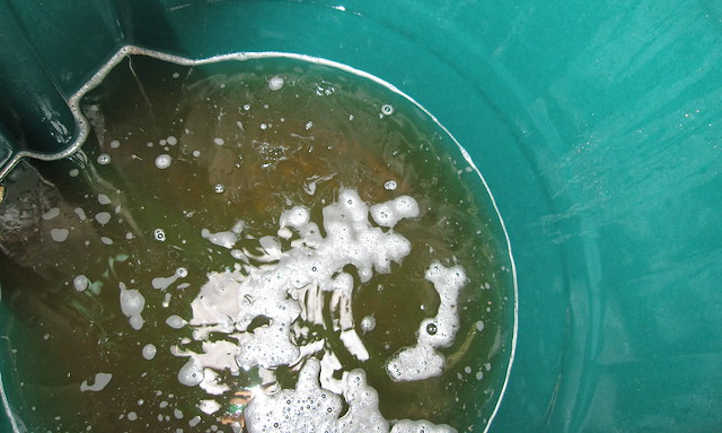
Whether you choose a wet, dry, or small system for your garden or home, note the following.
Divert the First Rain
This keeps your catchment system clean. Often your roof collects dirt, ash, and debris from nearby trees or the environment. Diversion is especially important if you are collecting potable water for drinking. The first rain of the season will rinse the roof clean, and you don’t want that going into your barrel, so a water diverter can help. Water diverters keep that initial flush of dirty water out of your tank, and then on subsequent rainfall, you can allow the water to flow into the tank debris-free. This can be as simple as attaching a flex hose to the gutter to move water to one side during the first storm or can be a built-in system controlled with a valve system. More complex water diverters can pump stormwater as needed, too.
Screen the Downspout
Another important thing to consider when water is collected from your roof is that some leaves from local trees may still flow into the downspout even after the first rain. Those will need a filter to catch them. Affix a screen over the downspout and the hole in your barrel or tank to keep them from getting plugged up. One excellent way to prevent leaves altogether is to place a leaf screen over your gutter. There are even filter systems that will keep out fine particulate matter. Dust or superfine ash may still get through your screen material.
Keep Out Mosquitoes
A huge issue to consider is mosquitoes. A mosquito looks at any standing water source as a fine breeding ground. To prevent mosquito larvae, use Mosquito Dunks or another similar product that contains Bacillus thuringiensis var. israelensis, as this is toxic to mosquitos but not humans or animals. To ensure they aren’t able to get into your tank at all, put together a catchment that is sound with a sealed rainwater barrel. Do this with a fine mesh over each opening. Cover the intake opening, decorative top, and overflow port.
Larger Catchment Systems
If you plan to go with a huge 5000 plus gallon system, it’s best to get some professional help. You’ll need lots of people to help you move a large tank (or two), and experts to set up something that is structurally sound.
If this is the way you go, know that you have plenty of filtering options. For instance, you can have a reverse osmosis water purification system installed that will pump non-potable water through a filtration system making it drinkable. Alternately. skip the drinkable option and have a greywater system set up to irrigate your crops as Kevin has done.
You can even bury a tank in the earth and save space in your yard. It’s possible to ensure there’s lots of curb appeal built-in to your design. A large barrel with wooden slats around it, or a fenced-off large tank, may be more appealing to someone who’s interested in collecting rainwater but not at the expense of visual appeal.
Frequently Asked Questions
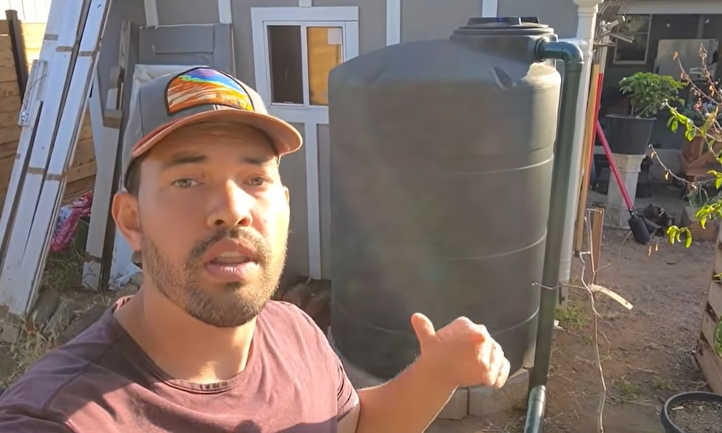
Q: What states is it illegal to collect rainwater?
A: It is legal to collect rainwater in every US state. However, there are stipulations in some states. Check with your county to determine the best options for you before you set something up.
Q: Can you turn rainwater into drinking water?
A: Local regulations will determine whether or not it’s legal to collect rainwater for drinking. It is possible, however, with proper filtration technology.


